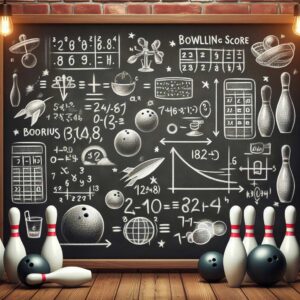Have you ever wondered why bowling balls come in different weights? As you stroll into a pro shop or browse online bowling stores, you’ll notice a wide range of bowling ball weights, typically ranging from 6 to 16 pounds.
This variation is not just for aesthetic purposes; it’s a crucial factor that can significantly impact your performance on the lanes. Whether you’re a seasoned bowler or just starting out, understanding the science behind bowling ball weights is essential to selecting the right one for your game.
In this comprehensive guide, we’ll delve into the reasons why bowling balls have different weights, the factors that influence weight selection, and how to choose the perfect ball weight to elevate your bowling game. So, grab your favorite ball, and let’s explore the fascinating world of bowling ball weights.
Understanding Bowling Ball Weights
Bowling balls come in a variety of weights to cater to different players’ needs and preferences. The typical weight range for bowling balls is between 6 and 16 pounds, with increments of 1 pound or less. While some manufacturers offer balls outside of this range, the vast majority fall within these parameters.
But why do bowling balls have such a wide weight range? The answer lies in the unique combination of physical attributes, playing styles, and lane conditions that each bowler encounters.
By offering a spectrum of weights, bowlers can select a ball that suits their individual requirements and maximizes their performance on the lanes.
Factors Influencing Bowling Ball Weight
Player’s Physical Attributes
One of the primary factors that influence the ideal bowling ball weight is the player’s physical attributes, such as height, strength, and arm swing.
Taller bowlers with longer arms may benefit from a heavier ball as they can generate more momentum and leverage during their swing. Conversely, shorter bowlers or those with less upper body strength may find lighter balls easier to control and release consistently.
The weight of the bowling ball also affects the ball’s speed and revolution rate (the amount of spin imparted on the ball). Heavier balls tend to have a higher ball speed but lower revolution rate, while lighter balls often have a lower ball speed but higher revolution rate. This relationship between weight, speed, and revolution rate plays a crucial role in determining the ball’s overall motion and hook potential on the lanes.
Playing Style
Another critical factor that influences bowling ball weight is the player’s preferred playing style. Broadly speaking, there are two main styles: stroker and cranker.
Strokers typically favor a more controlled and straight ball path, relying on precision and accuracy rather than excessive hook or curve. For these bowlers, a lighter ball weight may be preferred as it allows for better control and a smoother release.
On the other hand, crankers are bowlers who generate a significant amount of revolutions on the ball, creating a more pronounced hook or curve. These players often opt for heavier bowling balls, as the added weight helps them generate more power and leverage to create the desired ball motion.
Lane Conditions
The condition of the bowling lanes, including the oil pattern and surface texture, can also influence the ideal ball weight. On heavily oiled lanes, a heavier ball may be more suitable as it can better cut through the oil and generate the desired motion.
Conversely, on drier lanes or lanes with less oil, a lighter ball may be preferred as it will create less friction and allow for a smoother transition through the breakpoint.
Benefits of Different Bowling Ball Weights
Lighter Weights (6-10 lbs)
Lighter bowling ball weights, ranging from 6 to 10 pounds, offer several benefits for specific groups of bowlers. These balls are ideal for children, seniors, or individuals with physical limitations or injuries that may prevent them from comfortably handling heavier weights.
Lighter balls allow for more control and consistent releases, reducing the strain on wrists, arms, and back. This can be particularly beneficial for those recovering from injuries or seeking to minimize the risk of potential injuries associated with the repetitive motion of bowling.
Medium Weights (11-14 lbs)
The medium weight range, typically between 11 and 14 pounds, is a popular choice for many amateur and recreational bowlers. These weights strike a balance between control and power, offering a versatile option for various playing styles and lane conditions.
Bowlers who prefer a moderate hook potential and a blend of accuracy and pin-carrying power often gravitate towards medium-weight balls. This weight range allows for a smooth delivery while still generating enough force to knock down pins effectively.
Heavier Weights (15-16 lbs)
At the higher end of the weight spectrum, balls weighing 15 or 16 pounds are often preferred by professionals and high-level players. These heavier weights offer increased pin-carrying power and strike potential, making them ideal for those seeking maximum scoring potential.
However, it’s important to note that handling heavier bowling balls requires exceptional technique and physical strength. Without proper form and conditioning, using excessively heavy balls can increase the risk of injury and negatively impact overall performance.
Factors to Consider When Choosing Ball Weight
Selecting the right bowling ball weight is a personal decision that should take into account various factors. Here are some key considerations:
- Personal Strengths and Weaknesses – Evaluate your physical abilities, flexibility, and any potential weaknesses or limitations. If you have a history of injuries or struggle with certain aspects of the game, a lighter or medium-weight ball may be more suitable to minimize strain and improve consistency.
- Desired Ball Reaction/Motion – Consider your preferred ball motion and the amount of hook or curve you want to generate. If you prefer a straighter ball path, a lighter weight may be more appropriate. Conversely, if you enjoy creating a more pronounced hook or curve, a heavier ball weight can help you achieve that desired motion.
- Physical Conditioning and Injury Prevention – Bowling is a repetitive sport that can put strain on various parts of the body, particularly the wrists, arms, and back. Choosing a ball weight that is comfortable and manageable for your level of physical conditioning can help prevent potential injuries and ensure long-term enjoyment of the sport.
- Consistency and Comfort During a Multi-Game Session – Consider the length of your typical bowling session. If you often bowl multiple games in a single outing, a ball weight that feels comfortable and manageable over an extended period can help you maintain consistent performance throughout the session.
Properly Drilling and Matching Ball Weight
Once you’ve selected the appropriate bowling ball weight, it’s essential to ensure that the ball is properly drilled and matched to your specific grip and span. A well-drilled ball can significantly enhance comfort, control, and overall performance.
- Importance of Getting a Ball Drilled to Your Specific Grip and Span – A ball drilled specifically for your grip and span (the distance between the thumb and finger holes) can greatly improve your release and overall ball motion. An improperly drilled ball can lead to inconsistent releases, decreased accuracy, and potential injury.
- Balancing Static Weights for an Even Swing – In addition to grip and span, the static weights (the distribution of weight within the ball) play a crucial role in achieving an even, balanced swing. Experienced pro shop operators can ensure that the static weights are properly balanced, allowing for a smoother and more controlled delivery.
- Using a Ball Weight That Complements Your Physical Capabilities – Finally, it’s essential to choose a ball weight that complements your physical capabilities. While a heavier ball may seem appealing for its potential power, if it exceeds your strength and conditioning levels, it can lead to poor technique, inconsistency, and potential injuries. Listen to your body and select a weight that you can comfortably handle throughout an entire bowling session.
Conclusion:
In the world of bowling, ball weight is not just a matter of personal preference; it’s a strategic decision that can significantly impact your performance on the lanes.
Different bowling ball weights cater to various playing styles, physical attributes, and lane conditions, allowing bowlers to find the perfect match for their game.
Whether you’re a seasoned pro or a beginner, understanding the science behind bowling ball weights can help you make an informed decision when selecting your next ball.
Experiment with different weights, observe how they affect your game, and don’t be afraid to seek guidance from experienced bowlers or pro shop operators.
Remember, the key to success in bowling lies in finding the right balance between ball weight, technique, and physical capabilities. By choosing the appropriate ball weight and ensuring proper drilling and matching, you’ll be well on your way to achieving consistent strikes and enjoying the sport to its fullest.
So, the next time you step onto the lanes, take a moment to appreciate the weight of your bowling ball and the science behind its purpose. Happy bowling!





